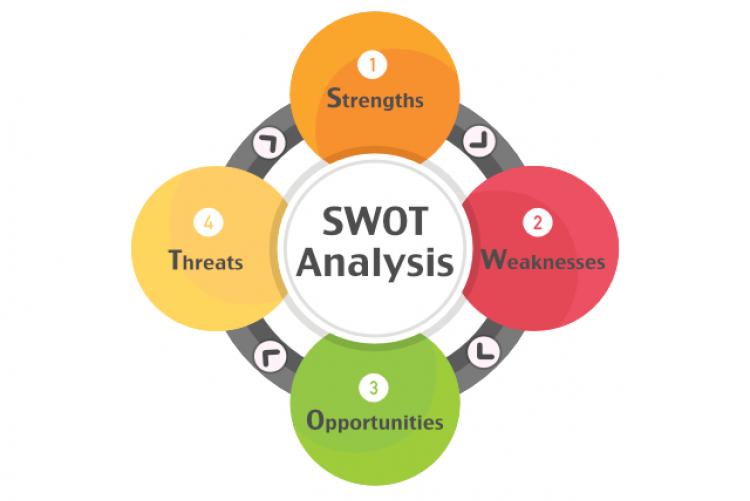Why a Business SWOT Analysis is Vital to Success
What is a business SWOT analysis? In short, it is one of the most useful—but rarely used—strategic planning tools for young businesses.
A thorough business SWOT analysis is an essential component of any business plan. Whether launching a new product, expanding into a new market, or choosing viable business partners—literally every business-shaping initiative can be improved when a company looks carefully at the internal and external factors affecting its projects.
But few young companies leverage a business SWOT analysis. Fewer still leverage it correctly.
This lack of early strategizing plays a big part in why an estimated 98% of businesses close up shop in their first year. That is a horrifying number, but it’s also higher than it needs to be. If more companies were willing to conduct a serious business SWOT analysis—or enlist a business partner to assist in conducting one—there is no telling how many companies might establish themselves as vital, profitable businesses focused on growth rather than survival.
What Is a Business SWOT Analysis?
There is some debate about the origins of the term SWOT, but its meaning has been the same for almost fifty years. SWOT is a four-component method of evaluating the viability of business ventures and devising an appropriate strategy for bringing them to life, also known as finding a strategic fit.
It is often recommended that a company perform a business SWOT analysis for any important initiative. However, it is critical for a young business to perform a business SWOT analysis of their overall business plan.
The four components of a SWOT analysis are:
- Strengths
- Weaknesses
- Opportunities
- Threats
SWOT can also be broken down into internal and external factors, with Strengths and Weaknesses being internal factors and Opportunities and Threats external. Let’s look at the internal factors first.
Internal Factors: Strengths and Weaknesses
The simplest part of a business SWOT analysis is determining a venture’s internal Strengths and Weaknesses—resources, capital and products.
Strengths are often top-of-mind for most business owners. They are what the business was originally based on. And, as humans, we are generally most aware of the things we’re proud of.
Weaknesses also tend to be easily identified. Most businesses simply look at their strengths and see what’s missing, or they may already have in mind shortcomings in place when the company began.
Potential Strengths:
- Talented staff with valuable skillsets
- Experienced leadership
- Resources and assets
- Competitive advantages
- Marketing awareness
- Location
- Price, or quality
Potential Weaknesses:
- Capability gaps
- Lack of reputation in the marketplace
- Low morale or irresolute leadership
- Shortage of resources
- Limited cash flow
- Inexperienced staff
But this only covers half of a company’s concerns. A proper business plan has to include the external factors facing a business to determine a profitable way forward.
External Factors: Opportunities and Threats
Examining the Opportunities and Threats facing a business is of immense strategic value. This second half of a business SWOT analysis helps determine a company’s position in the marketplace. If performed properly, it will also indicate how that position can be improved.
Opportunities are situations deemed beneficial to a company’s current business objectives.
Threats are potential obstacles to success.
Opportunities and Threats are based on constantly changing external factors. Consequently, they can be difficult to identify—and even harder to leverage. They are crucial factors in deciding whether a business goes full steam ahead, pivots or abandons their position altogether.
Potential Opportunities:
- Changes in markets
- New vulnerabilities in competitors
- Favorable trends
- Seasonal factors
- New partnerships and contracts
- Innovation
Potential Threats:
- Regulatory restrictions
- Competitor innovations
- Economic disruption
- Loss of critical partnerships
- Shrinking demand
- Unfavorable trends
Once a business SWOT analysis has been performed, what then? Sadly, it’s a question many companies don’t know how to answer.
Putting a Business SWOT Analysis to Work
While the main issue concerning business SWOT analysis is that most companies don’t use them, those that do often come up short when attempting to turn their SWOT results into business-driving strategies. Some common mistakes when performing a SWOT analysis include:
1. Thinking of SWOT as Just a List
Too many companies compile exhaustive, often impressive lists of their Strengths, Weaknesses, Opportunities and Threats. However, they don’t put in the critical thinking necessary to follow up by strategizing solutions for their Weaknesses and Threats. Identifying a problem is not the same as solving it; identifying a strength is not the same as leveraging it.
2. Rushing
A business SWOT analysis should be as comprehensible as possible. Regardless of the time required, multiple perspectives should be consulted on each component. Time must be set aside for discussion , collaboration and additions and changes.
3. Asking the Wrong Questions
Information is key to a business SWOT analysis. If it is based on questions that are too simple or focused on the wrong aspects, the resulting information will be incomplete or inaccurate. This will almost always lead to misguided strategies.
4. Focusing Solely on the Present
Although most business SWOT analyses emphasize a strategic fit, most experts would suggest a “stretch”. This is a strategy that can adjust to the inevitable changes that are bound to affect business in the near future.
Looking at this list of common errors, it becomes clear that performing a business SWOT analysis is far from simple. Similarly, information gleaned from one does not magically transform itself into strategy. Strategy demands insight and experience—two qualities many new business owners just don’t have.
The irony is that success breeds insight and experience. But how can a new business achieve that initial success?
Painted Lemur Studios and your Business SWOT Analysis
As part of our Small Business Kick-Start program, Painted Lemur Studios will conduct a robust, objective business SWOT analysis of your organization. This will identify Strengths, Weaknesses, Opportunities and Threats—many that may be unknown to your organization. We will then shape the results into an agile strategy that both fits and guides your business.
Our Executive Advisors have extensive experience plotting business strategies for a wide array of clients and products. Their insight—and foresight—can become a valuable asset for your business, guiding it from analysis to strategy to success.

